Flores saw how hard his family worked to earn a living. He also learned some hard personal lessons about the impact of health inequity. For instance, one day, while working at the family vegetable stand, Flores’ uncle suffered a massive heart attack due to diabetic complications and passed away at age 50. “As his disease progressed, my uncle had difficulty getting insurance coverage, seeing a physician to manage his diabetes, and getting his medication on time,” says Flores — who watched other relatives face similar challenges, including another uncle who couldn’t access smoking cessation resources and ultimately succumbed to meta-static lung cancer.
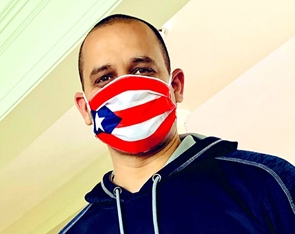 Efrén J. Flores, MD, was born and raised in Puerto Rico and eventually settled in on the U.S. mainland as a radiologist at Massachusetts General Hospital. |
This early exposure to healthcare disparities planted the seeds for a career in medicine, fueling Flores to become a radiology changemaker who is committed to advancing care for underserved patients. By harnessing his humble background to understand the challenges facing his community, Flores is eliminating barriers and promoting more equitable care.
Modeling Compassionate Care
While Flores’ parents were not wealthy, they emphasized the importance of family and education for their children. “Growing up, we didn’t have many resources, but I was fortunate to have a supportive environment from my parents and my grandparents, who lived next door,” says Flores, who has two older sisters. “My parents told me, ‘We don’t have the resources to give you an inheritance, but we’re going to make sure you get an education, so you can open doors for you and your family.’ They wanted us to have a better future.”Flores attended a Catholic elementary school in Puerto Rico, taught by nuns who were strict but selfless. “They were dedicated to serving others with genuine kindness,” he remembers. “They taught me to serve others without expecting anything in exchange.”
Inspired by his teachers, Flores dreamed of becoming a chemistry teacher. Once he started college, though, Flores realized that a lot of pharmaceutical companies were hiring sales reps in Puerto Rico, so he switched his major to biology and secured an internship at a pharmaceutical company as he entered his senior year at the University of Puerto Rico. But just before his intern-ship began, his plans shifted when a severe car wreck left his mother in a coma for a month.
“I spent a lot of time in the Medical Center at the University of Puerto Rico that summer. My dad and I took turns sleeping in the lobby, waiting to see if we’d get any news about her condition,” Flores says. “The doctors were so kind and generous with their time, taking care of my mom and explaining everything to us along the way. Although she had a long recovery, she survived. Not only was I grateful to God but also to the doctors who saved her when we thought we’d lost her. It made me want to pay it forward — to do the same for other people by providing the best care possible. I switched careers to pursue medical school so that I could make that kind of difference in people’s lives every day.”
A lifelong love of sports initially led Flores toward orthopedic surgery. However, during his third year of medical school at the University of Puerto Rico, he had to take electives in other specialties. For one elective, he chose radiology at the insistence of Josué Vazquez, MD, a college friend who was pursuing an imaging specialty and who recognized that Flores shared the collaborative spirit of a radiologist.
“Even as a student, he was always looking out for people’s wellbeing,” says Vazquez, now a radiologist in Puerto Rico. “There’s this perception about radiologists working alone in a dark room, and Efrén didn’t fit that description. But the chance to impact patients from every discipline was very enticing to him because he could serve a lot of people in so many ways.”
During his radiology elective, Flores found the teamwork between radiologists and trainees fascinating. “Radiology felt like a big happy family, where people were welcoming and willing to share their knowledge. I didn’t experience that level of camaraderie and collaboration in other specialties,” Flores says. “I grew up playing basketball, so that teamwork mentality was critical in my decision. Since radiology is truly a team sport, it’s definitely the right field for me.”
Moving to the Mainland
Once he chose the radiology path, Flores intended to practice in Puerto Rico. But first, he wanted a taste of medical training beyond the island. He and his fiancée (now wife), Catherine, who was studying psychiatry, both applied for rotations on the mainland. In the fall of 2004, they were accepted to a month-long visiting clerkship in Boston through Harvard Medical School.
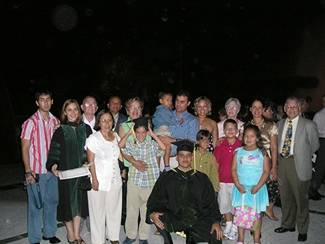 Flores and his wife, Catherine Gonzalez, MD, credit much of their success to their close-knit family, especially their parents. |
“That rotation changed my career trajectory,” says Flores, who spent that month in the radiology department at Beth Israel Deaconess Medical Center. “I saw the advancements in the latest technology in radiology during that rotation. And then at my first Radiological Society of North America meeting that December, I saw the up-and-coming innovations in radiology, and I was hooked.”
After the conference, Flores returned to Puerto Rico to tell his parents that he had decided to pursue his radiology residency on the mainland. Although leaving Puerto Rico was bittersweet, he couldn’t ignore the opportunities he saw on the mainland. “The reason I pursued medicine was to provide the best possible care,” he says. “Since radiology is a technology-dependent specialty, I needed access and exposure to the most advanced technology so I could bring that knowledge back home.”
He and Catherine applied for couples match into their respective residency programs, and together they matched in Boston, where he landed in the radiology department at Massachusetts General Hospital (MGH). They married in December of 2004.
By that time, Flores was already fluent in English as a second language because the books and tests in undergraduate and medical school were printed in English. Still, he wasn’t accustomed to speaking English all day, so it took some time to adjust to the language. But the biggest change was the harsh New England climate. “I went from white sand beaches to white snow and cold,” Flores jokes. “In Puerto Rico, it was warmer — both weather-wise and culturally; people seemed to be warmer. When you get in an elevator there, people start chatting, but I didn’t experience that here at first.”
That culture shock dissipated when Flores arrived in the radiology department at MGH, where the welcoming team mentality made him feel at home. “Everybody was approachable. Even the most accomplished radiologists were willing to give their time — not only to me and the other trainees but also to other specialties,” Flores says. “That collegiality made MGH feel like a radiology family, where people were open to collaboration because they were all focused on patient care.”
Integrating Care on Nantucket
In 2011, after finishing his radiology residency with a subspecialty focus split between abdominal and breast imaging and then completing his clinical fellowship in musculoskeletal radiology, Flores planned to return to Puerto Rico. But when one of his children was born with a congenital condition that required additional evaluation at Boston Children’s Hospital, they decided to stay in the Boston area.Around that time, the radiology department at MGH started covering Nantucket Cottage Hospital off the coast of Cape Cod. Since many of the imaging services that MGH provided at the hospital aligned with Flores’ areas of expertise, his mentors encouraged him to get involved. At their recommendations, Nantucket Cottage Hospital offered Flores the role of medical director in radiology. In this position, he split his time between MGH’s main campus (where he specialized in emergency radiology) and the island’s community hospital, where he guided the integration of imaging services.
Flores says, “Nantucket hospital provided me with an incredible leadership opportunity to get a glimpse behind the scenes of all aspects of a radiology practice.”
From May through November of 2011, Flores traveled between the two sites — arriving on Nantucket Monday morning, then returning to the main campus on Wednesday, then back to Nantucket for a couple days before coming home to Boston. During the summer, he spent most of the week on the island. “It was a busy summer, integrating the practice and making sure all of the protocols were in place,” says Flores, who provided clinical services and met with patients, physicians, and hospital leadership during the day and then stayed late to help the technologists adjust the scanning protocols to improve image quality. “I really enjoyed being involved in different aspects of care. It also helped me build trust with the providers and the community of Nantucket because it showed that we were all in it together.”
Uncovering Missed Care Opportunities
In 2013, the number of children in the Flores household suddenly doubled with the surprise arrival of twins, making it impractical for Flores to travel to Nantucket every week. When one of his mentors mentioned an opening in thoracic imaging at the main campus, which included on-the-job training, Flores jumped at the chance to learn another subspecialty to contribute to the radiology department at MGH.
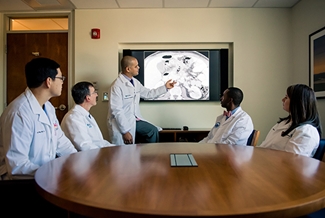 Flores, officer for radiology community health and equity at Massachusetts General Hospital, discusses a case with (left to right) Gary X. Wang, MD, PhD; James A. Brink, MD, FACR; McKinley Glover, MD, MHS; and Dania Daye, MD, PhD. |
About one year into this position, while interpreting thoracic MRIs, Flores experienced a pivotal patient encounter that transformed him into a health equity advocate. This patient, who had previously missed several appointments and been labeled a “no-show,” finally arrived for her imaging exam.
"I went to talk to the patient after the scan to see what brought her in this time — if she had any new symptoms or additional clinical information that could improve the accuracy of my diagnostic report,” Flores says. “She was Spanish-speaking, like myself, and she told me, ‘I missed the other two appointments because I didn’t understand the English reminders. This time I asked a friend to translate the message for me, and that’s why I came.’”
Flores couldn’t stop thinking about the patient’s experience as he completed his report. “It was a powerful eye-opener,” he says. “It made me wonder how many more patients, like her, were missing appointments because the system is not tailored for them.”
After this encounter, Flores systematically examined the issue, looking at all of the patients who had been labeled as “no-shows” for imaging appointments over the past year. He found that underrepresented minority patients, those who spoke English as a second language, and those with Medicaid were the most likely to miss their scheduled imaging exams. Wanting to improve care delivery for these patients, Flores shared his research with Radiologist-in-Chief James A. Brink, MD, FACR.
“Efrén is so passionate about supporting underserved patients to provide more equitable care in the community,” Brink says. “He educated me about this data and pointed out how we were blaming patients for missing their appointments when, really, the fault was ours.”
Brink encouraged Flores to rethink the language used to label these underserved patients. Instead of calling them “no-shows,” Flores began referring to these cases as “missed care opportunities.” “This term reflects how we, as a healthcare system, missed an opportunity to provide care to these individuals,” he says. “We tend to put the responsibility on the patients, but we have to take ownership and meet them where they are if we want to serve the patients who are not connecting with the healthcare system.”
This realization set everything in motion for Flores. From that moment, he dedicated his medical career to helping underserved patients overcome barriers to accessing care.
Finding a Place in Health Equity
With support from Brink and the rest of the radiology department, Flores shared his findings throughout the hospital and at national meetings. As his research, published in the Journal of the American College of Radiology (JACR®) in 2017 , gained attention from the radiology community, Flores realized that his focus on health equity as both a radiologist and a researcher was quite rare.
“In the beginning, I felt somewhat isolated because few radiologists at my institution were focused on disparities, and few people in radiology were looking at this through a research lens,” Flores says. “I had trouble getting traction because people thought that the only patients facing disparities were racial and ethnic minorities or those with limited English proficiency, when in reality, disparities affect many different populations. Health equity is about making sure that everyone has a fair opportunity to get timely care — and that’s one of my most important missions because of my background as a Latino individual and as a physician.”
Flores found himself having to justify his role in health equity as colleagues often asked him, “What is a radiologist doing in health disparities work?”
“Health equity is everyone’s responsibility, and there’s a role for everyone,” Flores explains. “Even though people perceive radiologists as not treating patients directly, we treat more patients than many other specialties because patients are referred to us from all different specialties. Every imaging study is a patient encounter. Radiology has a critical role in health equity because the patient population we see is a good representation of the community we serve.”
With the support of mentors like Joseph R. Betancourt, MD, MPH, senior vice president of equity and community health at MGH, Flores began pursuing health equity projects that fused his radiology insights with his passion for service.
“Coming from a humble background, Efrén really understands his privilege and responsibility as a healthcare professional representing people who didn’t have an opportunity to get where he is,” says Betancourt, who is also the founder and senior adviser of the MGH’s Disparities Solutions Center. “He has redefined how specialists can go above and beyond their day-to-day work to address community health while pushing radiology forward to be more thoughtful about improving care for vulnerable communities.”
Bridging the Gap in Care
Given his commitment to addressing care disparities, Flores was appointed as MGH’s first officer for radiology community health and equity. In this role, Flores is a liaison between the healthcare system and the surrounding community. He splits his time between the radiology department and the community health centers, looking for ways to connect with underserved patients by bridging barriers to care.
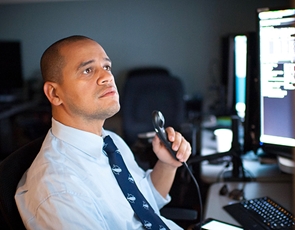 Flores is passionate about helping underserved patients overcome barriers to care. |
“To make care more accessible in the community, we can’t just sit at the main campus and say, ‘There are disparities,’” Flores says. “Going out and meeting with the people delivering care, as well as the patients and the community leaders, is an important step in understanding the barriers that our patients face and learning how these issues affect them.”
By leveraging his relationships in the community and his own perspective as a Spanish speaker, Flores innately empathized with Chelsea’s Latino population — which helped him develop solutions to the disparities he saw there. For instance, Flores knew from his own experience that hearing an unfamiliar language can be more confusing than seeing it in writing. So, he suggested switching from voice to text message appointment reminders.
And when Flores learned that many patients cited lack of transportation for missing or canceling their imaging exams, he collaborated with Brink and other radiology leaders to develop a rideshare program that assists patients who express transportation difficulties. “This program is an on-demand service that we offer to those patients who really need it,” Flores says. “If we can assist patients in filling that transportation gap, it goes a long way to building trust and improving the quality of care that we provide for these vulnerable patient populations.”
Improving Access to Cancer Screening
Motivated by the memory of losing his uncle to lung cancer, Flores has also looked for ways to improve lung cancer screening (LCS) access for underserved patients. For example, when he learned that patients with serious mental illness are up to four times more likely to die from lung cancer due to a higher smoking prevalence and challenges navigating the health system, Flores collaborated with providers at a community mental health clinic in Boston to improve access for this group. (Learn more in this JACR article .)“Efrén is dedicated to reaching out to vulnerable populations and making cancer screening accessible to all — not just for his patients but for the greater good,” says Elyse R. Park, PhD, MPH, a clinical health psychologist and health services researcher at MGH who collaborates with and mentors Flores. “He’s in an incredibly unique position to be a change agent because he really understands the voice of the community, and he represents the populations he’s trying to reach. He is an important bridge in the community because his passion is grounded in his own experience.”
To further expand LCS access, Flores has worked with radiologists and primary care physicians (PCPs) to facilitate LCS participation among individuals experiencing homelessness by offering eligible patients in this population the opportunity to receive LCS on the same day as their routine primary care appointments. He has also collaborated with breast imaging colleagues to offer eligible patients smoking cessation and LCS services at the same time as their screening mammograms. (Learn more in this JACR article .)
All of this work stems from Flores’ recognition that radiology can play a central role in care coordination with other specialties to maximize each encounter and help patients, particularly those who face multilevel barriers to care. “If a patient takes all the steps to connect with the healthcare system for one type of appointment, then we should consider what else we can do to maximize that encounter,” Flores says. “By offering them additional services, we can make care even more accessible.”
Serving in Times of Need
Although he has built his career in Boston, Flores still feels a deep connection to Puerto Rico. He travels back to the island two or three times a year to spend time with his relatives, close friends, and “radiology family” there. In both places, he’s always looking to fill unmet needs, especially during times of tragedy, which can highlight socioeconomic disparities.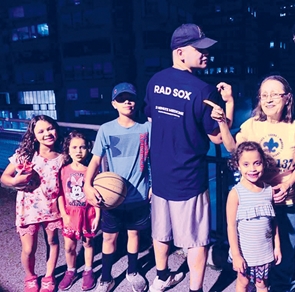 Flores poses with his children and mother in-law after playing a game with the radiology softball team, Rad Sox, as part of the MGH league. Flores draws inspiration and life lessons from team sports. |
“Efrén collaborated in launching a major effort to help our colleagues in Puerto Rico after the hurricane,” Brink remembers. “At the time, I thought it sounded crazy because he was trying to do so much more than what we normally do. I never imagined that we, as a radiology department, would be joining an effort to charter a plane full of medical supplies. But he pulled it off, and it was very impressive.”
Flores helped Viejo pack six 50-pound boxes of supplies to take back with him on the plane and then helped to coordinate continued donations as Puerto Rico recovered from the damage. “Efrén was my right-hand man in this whole process, and I couldn’t have done it without him,” Viejo says. “On Oct. 31, a plane landed in Puerto Rico with over 152,460 pounds of medical supplies from several institutions. Of that, 20,000 pounds were from of Mass General, thanks to Efrén’s urgency to help.”
Several years later, when COVID-19 cases began to surge in Boston, Flores was quick to volunteer beyond his normal duties to serve patients, especially in Chelsea — one of the hardest hit communities in the country. While reading chest radiographs in the respiratory clinic, Flores noticed that Latino patients at the Chelsea HealthCare Center were presenting more severe symptoms than patients at other Boston sites. At one point, he says, half of the intensive care patients were from Latino communities.
“The pandemic highlighted how social determinants directly impact health outcomes for those who are most vulnerable,” says Flores, who published his COVID-19 disparity research in 2020. “It was heartbreaking to see, but it showed that everybody has a role in health equity, particularly in times of crisis.”
When the hospital launched its Spanish Language Care Group to provide interpretation services for Spanish-speaking COVID-19 patients and their families, Flores volunteered immediately. (Learn more in this article .) Outside of the hospital, Flores leveraged his relationships in the Chelsea community to promote proper safety measures by filming public service announcements about handwashing, social distancing, and vaccinations. (See video one and video two .)
“They know I’m part of their community,” he says. “These long-term relationships are critical in times of need because trust is not built overnight. To foster these relationships in the community, we need to leverage trusted voices, not only from people who look like them, but from people they know.”
Setting an Example
With his equity and healthcare disparities research, community outreach, multidisciplinary collaborations, and other projects, Flores maintains a busy schedule. On top of it all, he carves out time for his 13-year-old son, 10-year-old daughter, and twin girls, age 8. Whether he’s shooting hoops in the driveway with his son or taking him to baseball, driving one of his daughters to gymnastics, softball, or soccer practice, or showing the kids how to cook a traditional Puerto Rican dish, Flores pays attention to the skills and lessons he’s modeling for his children.“Every day when I wake up and see my kids, I wonder, ‘Am I setting a good example?’” Flores says. “That’s a key motivator for me because the health equity model we’re building now is creating a framework for the next generation.”
Although Flores wants his kids to know how his work helps secure a better future, he emphasizes that this work does not come before them. “I’ll always make time for my kids because they are my number one priority,” he says. “I try to be equitable with my time distribution by staying involved in their activities.”
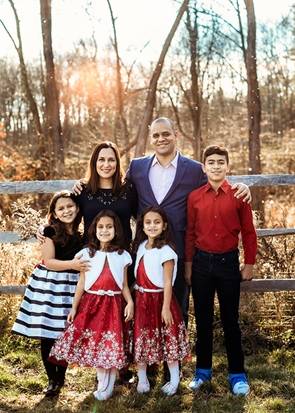 Family is Flores' number one priority. He's committed to setting a good example for his children. |
“In sports, everyone has a role in achieving the common goal, but sometimes ego can get in the way,” says Flores, who participated in an adult basketball league at the local YMCA before the COVID-19 pandemic. “If our goal is to win as a team, then we have to uplift each other because we can accomplish more together than alone. In the same way, we, as radiologists, have to break down silos to advance health equity in collaboration with other organizations and across specialties because it truly takes a team effort.”
With the same enthusiasm that he uses to cheer on his children’s teams, Flores encourages other radiologists and referring physicians to engage in health equity. He looks for opportunities to “pass the ball” to other collaborators. For example, as part of his COVID-19 research, Flores partnered with medical students in Puerto Rico to translate patient summaries, infographics, and other information from English to Spanish for the JACR. It was a concrete way to get them involved for the sake of the patients, he says. (See an infographic.)
“Being a Latino man who works in this space, Efrén serves as a visible example of the impact a radiologist can have in health equity,” says Ruth C. Carlos, MD, MS, FACR, assistant chair for clinical research at the University of Michigan and editor-in-chief of the JACR. “He shows how we can engage outside of our silo to materially change the way we deliver care. In doing this, he embodies what I believe is the future of radiology.”
As a role model not only for his own children but also for other trainees and clinicians across the country, Flores wants to inspire the next generation through his work. “I can’t achieve health equity alone, just like I can’t win a basketball game by myself,” he says. “If we really want to inspire change through this work, we need to open up doors for others to get involved and lift each other up so that people understand that they have a valuable role to play in health equity — because we all do.”
Making a Difference Each Day
Thanks in part to changemakers like Flores who fearlessly advocate for underserved patients, the national conversation about health equity has gained traction over the last several years. More radiologists are taking an active role in this space, with organizational support from associations like the ACR.“Having the backing of such a respected institution like the ACR validates this work and underscores that Imaging 3.0TM is not limited to one care setting or even one department,” says Flores, a member of the Population Health Management Committee of ACR’s Commission on Patient- and Family-Centered Care. “The ACR has provided a home for people to come together and talk about radiology’s role in health equity as the conversation has shifted from, ‘Why should we be involved?’ to, ‘What can we do, and how can we do it together?’”
By inspiring other collaborators to get involved, Flores hopes to spur change. “Even though we’ve accomplished a lot, there’s a lot more to do, so we can’t rest,” he says. “This is a marathon, and that’s why it’s important to have continued motivation to pay it forward to every single patient we see. By taking ownership of each encounter, we can transform healthcare delivery one small win at a time.”
Author
Brooke Bilyj, freelance writer
Join the Discussion

#Imaging3 on Twitter
Call for Case Studies
